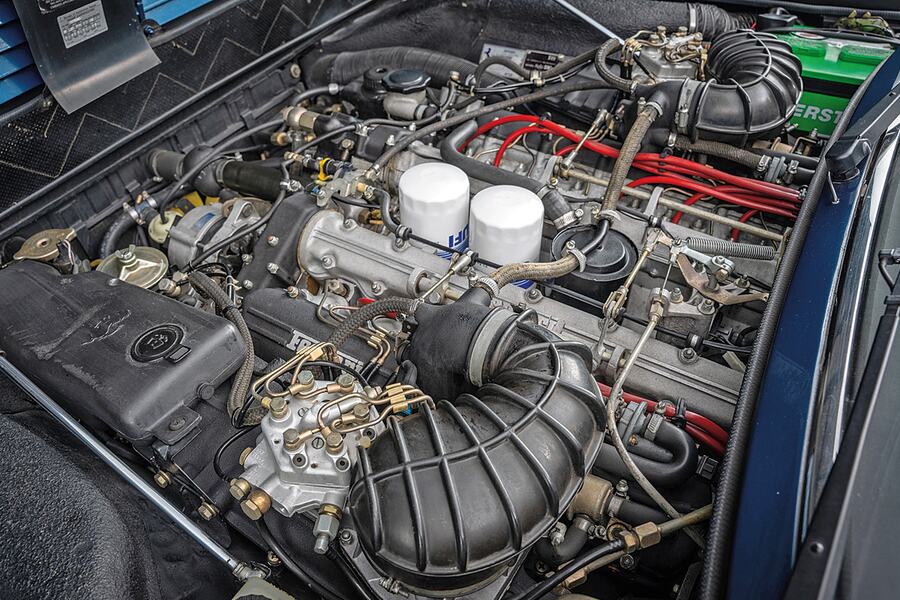In the first week of January, while checking out the Ferraris for sale on Bring A Trailer, I came across a very nice-looking 412. Blue inside and out, it boasted a manual transmission instead of the more common automatic—and then, as I scrolled down the page, I discovered a photo of the car when it was featured in our May 2000 issue [“Sublime Luxury for Four, ’80s-style,” FORZA #29]. If that wasn’t surprising enough, it turned out the Ferrari was literally just around the corner from our offices. A few emails and a couple of days later, I walked over to Genau AutoWerks (BaT’s Local Partner for the San Francisco Bay Area, which had photographed the 412 in its in-house studio before listing it for sale) for a reunion of sorts.
It would be a first for me, never having driven (or even sat in) a 412. Although I was in high school when the model was unveiled, I don’t remember the car from my teenage years—unlike the 288 GTO, 328, Testarossa, and F40. That’s understandable in that Ferrari’s 2+2s rarely received the press coverage of its sports cars, but less so given that, by 1985, the basic body style had been around for more than a decade.
In 1972, Ferrari had unveiled the angular 365 GT4 2+2 as a replacement for the 365 GTC/4. While the GTC/4 was only built for two years, the GT4 2+2 and its 400, 400i, and 412 evolutions would remain in production, with relatively few changes, until 1989.

Underneath their Pininfarina-penned bodies, these 2+2s were classic Ferrari Grand Tourers, built on a steel chassis (in this case, a wider and longer version of the GTC/4’s, with the longest wheelbase yet from Maranello) with a large-displacement DOHC V12 engine mounted up front, partnered with a five-speed manual or, beginning with the 400 in 1976, three-speed automatic transaxle.
The automatic proved the preferred choice of buyers, with more than two-thirds of cars so equipped. That’s no surprise given these Ferraris’ luxurious mission; full leather interiors, air-conditioning, power steering (another first, along with the automatic), electric windows, and more were all standard, while standard electric seats and a (previously optional) rear air-conditioning system arrived with the 412.
Over the years, the cars’ engines grew in size and output. The 365 GT4 2+2’s V12 displaced 4,290 cc and produced 340 hp and 319 lb-feet of torque. That climbed to 4,823 cc and 340 lb-ft in the 400, though the fuel-injected 400i, introduced in 1979, lost around 30 hp and 50 lb-ft. The 412’s 4,943-cc engine restored most of the lost output, producing 340 hp and 333 lb-ft, good for a 0-62 mph time under seven seconds and a top speed of 155 mph.

While the basic body remained the same across all four models, minor changes such as wheels, spoilers, and variously painted panels differentiated them. Compared to the 400i, the 412 received body-colored bumpers and taillight panel, as well as a new chin spoiler and flat-face wheels similar to those on the Testarossa. All told, 576 examples of the 412 were built over five years, and none were exported to the U.S.
AS WINSTON GOODFELLOW WROTE IN THAT long-ago article, our featured 412 was bought new by Don Meder of Southern California, who had put 53,900 miles on it by January 2001. When I drive it in January 2025, the odometer reads 64,285 miles, and the car has just been sold by its fourth owner, who asks to go by his first name, Ruben. Like me, Ruben is a child of the 1980s, which factored heavily in his choice of marque.
“All of us grew up watching Magnum, P. I., and that Ferrari 308 was the poster on my bedroom wall,” he recalls. “When I finally had the opportunity to buy a Ferrari, around 15 years ago, I bought a 308.

“But I also wanted a V12,” he continues. “Growing up in Miami, I saw lots of grey-market 400s coming in. They looked so cool with the angular lines and I knew I had to have one. I resigned myself to it being an automatic, but then I found this one for sale in the summer of 2015 at a classic car dealer. The Ferrari stood out like a sore thumb because it was the nicest car they had by a large margin, plus it was a five-speed and California-legal.
“So my wife and I flew to New York where this dealer was, and I had [vintage Ferrari mechanic and occasional FORZA contributor] Tom Yang do a PPI on it. Tom’s an awesome guy, and he was kind enough to let me come by and look over his shoulder when he did it. I learned a ton about the car, confirmed that I was in love with it, and, with his blessing, I bought it.”
After Meder, the 412 had been sold to a mechanic in the Pacific Northwest. He put a lot of work into the Ferrari, then sold it to a third owner in Southern California.

“The third owner had the car repainted by Gary Bobileff,” says Ruben. “I think the second owner had the dash and the center console recovered, but the rest of the interior —the seats, the headliner, the carpets—is original. It was clear the car had been really well cared for and preserved; it was in remarkable condition for a nearly 40-year-old car.”
What did Ruben like most about the 412?
“It was a cruiser, but it was still a Ferrari, and I loved driving up in the Santa Cruz Mountains and down Highway One,” he says. “It had this really cool characteristic that, when you pushed it into the tight turns, it kind of shrunk around you. It had really beautiful driving dynamics with fantastic balance. I had the suspension rebuilt after I bought it, and the car just went down the road beautifully. Of course you had the engine and the manual transmission, too, but really it was the entirety of the experience. Plus, it looked incredibly low and incredibly long, and just had tremendous presence.”

HE’S NOT WRONG ABOUT THAT PRESENCE; the 412 really does looks striking, with a clean, handsome profile that feels of a period rather than dated. The long, low hood isn’t as angular as it can appear in photos—there’s a definite curve to the front fenders—and Pininfarina’s classic blood groove helps keep the sides from feeling plain. Overall, it’s a clean and simple yet sophisticated design. The five spoke wheels are a perfect fit, as are the quad taillights and quad exhausts, and the blue hue really sets off the lines.
The cockpit turns out to be a wonderful place to sit, albeit a somewhat contradictory one, being both small and airy. There’s plenty of headroom for my 5-foot-10 frame, while the thin A, B, and C-pillars combine with the generous greenhouse for a spacious feeling with excellent outward visibility. In addition, the interior’s condition is so good everywhere I look it’s difficult to believe how old the Ferrari is.
Its age is clear in some areas, though, such as how I’m sandwiched between the center console and the door panel. The three-spoke steering wheel is tilted too far forward, as was Ferrari’s style at the time (though it’s not as extreme as in a 308), the seating position demands bending my knees and stretching out my arms, and the wheel’s rim blocks both the top of the tachometer and speedometer as well as the turn signal indicators. But the seats are very comfortable, the tall gear level is nicely positioned in the center console, very close to the wheel, and if that console is packed full of buttons, at least they’re all cleanly laid out and clearly labeled. Overall, it’s a surprisingly comfortable place to be, particularly when the engine fires up.

The 5-liter V12 catches after a few seconds of turning over, immediately settling into a deep, rumbling, gently loping idle. It revs briskly when I prod the throttle a few times, but, despite both Goodfellow and Ruben’s enthusiasm, I’ll admit I don’t have high hopes for the driving experience. Leaving aside the 1970s’ engineering, 340 hp and a claimed 3,979-pound dry weight don’t sound like a recipe for high performance. But then this Ferrari was built for touring, so that’s how it should be judged.
The first thing I notice about this stick-shift 412 is that the clutch pedal is heavy. Really heavy, heavier in my memory than the one in the last Daytona I drove. It’s progressive with a nice bite, and I think about it less the longer I’m in the car, but it remains out of character with the rest of the driving experience.
The second thing is that the transmission doesn’t like to go into second gear when it’s cold. This means, as I hit every stoplight on the way to the freeway, either trying to gently ease the stick into second while losing speed or revving higher in first gear and shifting straight into third. The V12 doesn’t take offense in either case, pulling smoothly from around 1,000 rpm without complaint. Once the transmission is up to temperature, the shift action is impressively tight and precise.
The third thing is, well, the 412 is a great car to drive. Not in a particularly sporting sense, but in the way it communicates with the driver and interacts with the road.
For example, while the chassis doesn’t feel modern, even in the context of a 456, it’s planted, communicative, and comfortable. While I can feel the suspension crashing over bumps, it’s a distant sensation, one that’s well-damped by the shock absorbers and high-profile tires (240/55VR-16s at all four corners). Wind noise is surprisingly subdued, while the engine’s growl is a constant and enjoyable presence. Overall, the 412 is all-day comfortable.
As expected, this Ferrari isn’t particularly quick by recent standards. There’s an urgency once the V12 comes on song around 4,000 rpm (peak power arrives at 6,000, 500 rpm before redline), but the 412 gathers pace steadily rather than rapidly. That matters less than it might, however, thanks to the engine’s deep-throated bellow, which proves endlessly entertaining.
While the slow steering is vague on center, and there’s a fair amount of body roll and not a lot of grip, the Ferrari feels very nicely balanced. The overall vibe is relaxed, yet the 412 is an engaging, communicative car; I want to drive simply for the feel of it moving down the road. It’s a captivating old-school experience, and, as mentioned, I never suspected beforehand this Ferrari would prove to be so enjoyable.
I’m certainly not the only one who likes the 412. In his 2001 article, Goodfellow quoted a period review from Road & Track, in which Phil Hill nicely summarizes my, Goodfellow, and Ruben’s impressions.
“It’s lovely,” wrote the 1961 World Champion. “[It is] the kind of car you’d just like to keep driving all day. The ride is civilized, yet the road holding and balance are so good you can do anything with it.”







